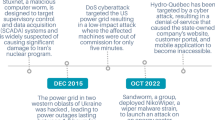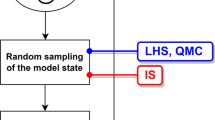Abstract
Large-scale natural disaster or malicious attacks could cause serious damages to the communication network in smart grids. If the damaged network cannot be recovered timely, greater threat will be brought to the secure and stable operation of smart grids. In this paper, a link importance-based network recovery method for large-scale failures in smart grids has been proposed. Firstly, the link importance for the network can be obtained according to the link importance for the service type and the importance of the service type for the network; secondly, a network recovery model, which is 0–1 integer programming, has been established to recover more important communication services with limited recovery resources; finally, we propose a heuristic algorithm to solve the problem and reduce the computational expenditure. The simulation experiments are carried out to evaluate the performance of the proposed algorithm. The simulation results illustrate that our network recovery method is applicable to the large-scale failures and the link which carries the high-priority service can be first recovered in this paper, thus which further ensures the safe and stable operation of smart grids.







Similar content being viewed by others

References
Zhang, X., et al. (2017). Effects of cyber coupling on cascading failures in power systems. IEEE Journal on Emerging and Selected Topics in Circuits and Systems, 7(2), 228–238.
Kong, P. Y. (2017). Cost efficient data aggregation point placement with interdependent communication and power networks in smart grid. IEEE Transactions on Smart Grid, 10(1), 74–83.
Lu, R., & Hong, S. H. (2019). Incentive-based demand response for smart grid with reinforcement learning and deep neural network. Applied Energy, 236, 937–949.
Chen, L., Jiang, D., Song, H., et al. (2018). A lightweight end-side user experience data collection system for quality evaluation of multimedia communications. IEEE Access, 2018(6), 15408–15419.
Wang, F., Jiang, D., Wen, H., et al. (2019). Adaboost-based security level classification of mobile intelligent terminals. The Journal of Supercomputing, 75(11), 7460–7478.
Bartolini, N., et al. (2017). On critical service recovery after massive network failures. IEEE/ACM Transactions on Networking (TON), 25(4), 2235–2249.
Genda, K. (2017). Effective network recovery with higher priority to service recovery after a large-scale failure. In 2017 23rd Asia-Pacific Conference on Communications (APCC) (pp. 1–6), Perth, WA.
Genda, K., & Kamamura, S. (2016). Multi-stage network recovery considering traffic demand after a large-scale failure. In 2016 IEEE International Conference on Communications (ICC) (pp. 1–6). IEEE.
Tootaghaj, D. Z., Bartolini, N., Khamfroush, H., & La Porta, T. (2018). On progressive network recovery from massive failures under uncertainty. IEEE Transactions on Network and Service Management, 16(1), 113–126.
Huo, L., Jiang, D., & Lv, Z. (2018). Soft frequency reuse-based optimization algorithm for energy efficiency of multi-cell networks. Computers & Electrical Engineering, 66(2), 316–331.
Jiang, D., Li, W., & Lv, H. (2017). An energy-efficient cooperative multicast routing in multi-hop wireless networks for smart medical applications. Neurocomputing, 2017(220), 160–169.
Jiang, D., Zhang, P., Lv, Z., et al. (2016). Energy-efficient multi-constraint routing algorithm with load balancing for smart city applications. IEEE Internet of Things Journal, 3(6), 1437–1447.
Jiang, D., Huo, L., Lv, Z., et al. (2018). A joint multi-criteria utility-based network selection approach for vehicle-to-infrastructure networking. IEEE Transactions on Intelligent Transportation Systems, 99, 1–15.
Jiang, D., Huo, L., & Li, Y. (2018). Fine-granularity inference and estimations to network traffic for SDN. PLoS ONE, 13(5), 1–23.
Jiang, D., Wang, Y., & Lv, Z. et al. (2019). Big data analysis-based network behavior insight of cellular networks for industry 4.0 applications. In IEEE transactions on industrial informatics (pp. 1–1).
Huo, L., Jiang, D., & Zhu, X. et al. (2019). A SDN-based fine-grained measurement and modeling approach to vehicular communication network traffic. In: International Journal of Communication Systems (pp. 1–12).
Jiang, D., Wang, W., Si, L., et al. (2018). A compressive sensing-based approach to end-to-end network traffic reconstruction. IEEE Transactions on Network Science and Engineering, 5(3), 1–12.
Zhu, J., Song, Y., Jiang, D., et al. (2018). A new deep-Q-learning-based transmission scheduling mechanism for the cognitive Internet of things. IEEE Internet of Things Journal, 5(4), 2375–2385.
Kaptchouang, S., Tahara, H., & Oki, E. (2016). Link weight optimization scheme for link reinforcement in ip networks. IEICE Transactions on Communications, 100(3), 417–425.
Li, H. et al. (2016). A declarative failure recovery system in software defined networks. In 2016 IEEE International Conference on Communications (ICC) (pp. 1–6). IEEE.
He, L., et al. (2017). Congestion-aware local reroute for fast failure recovery in software-defined networks. IEEE/OSA Journal of Optical Communications and Networking, 9(11), 934–944.
Yan, J., Xu, J., et al. (2016). Impact of communication system interruption on power system wide area protection and control system. Automation of Electric Power Systems, 40(5), 17–24.
Lv, Z. et al. (2019). Intelligent security planning for regional distributed energy internet. In IEEE transactions on industrial informatics (vol. 99, pp. 1–1).
Ashok, A., Govindarasu, M., & Wang, J. (2017). Cyber-physical attack-resilient wide-area monitoring, protection, and control for the power grid. Proceedings of the IEEE, 105(7), 1389–1407.
Baidya, P. M., & Sun, W. (2017). Effective restoration strategies of interdependent power system and communication network. The Journal of Engineering, 2017(13), 1760–1764.
Lin, H., et al. (2018). Self-healing attack-resilient PMU network for power system operation. IEEE Transactions on Smart Grid, 9(3), 1551–1565.
Wang, F., Jiang, D., & Qi, S. (2019). An adaptive routing algorithm for integrated information networks. China Communications, 7(1), 196–207.
Li, X., et al. (2018). Minimizing multicast routing delay in multiple multicast trees with shared links for smart grid. IEEE Transactions on Smart Grid., 99, 1–1.
Jia, H., Xue, K., Ma, J., et al. (2016). Improved Ant Colony algorithm for multipath routing selection in wide-area protection communication system. Automation of Electric Power System, 40(22), 22–26.
Yi, T., Li, F., Wang, Q., et al. (2017). Quantitative evaluation of communication system fault effect on real-time load control power system. Electric Power Automation Equipment, 27(2), 90–96.
Fan, B., & Tang, L. (2014). Vulnerability analysis of power communication network. Proceedings of the Csee, 34(7), 1191–1197.
Eppstein, D. (1998). Finding the k Shortest Paths. SIAM Journal on Computing, 28(2), 652–673.
Huo, L., & Jiang, D. (2019). Stackelberg Game-based energy-efficient resource allocation for 5G cellular networks. Telecommunication System, 23(4), 1–11.
Sun, M., Jiang, D., Song, H., & Liu, Y. (2017). Statistical resolution limit analysis of two closely spaced signal sources using Rao test. IEEE Access, 5, 22013–22022.
Jiang, D., Huo, L., & Song, H. (2018). Rethinking behaviors and activities of base stations in mobile cellular networks based on big data analysis. IEEE Transactions on Network Science and Engineering, 1(1), 1–12.
Acknowledgements
This work was supported by the Fundamental Research Funds for the Central Universities 2017 MS113.
Author information
Authors and Affiliations
Corresponding author
Additional information
Publisher's Note
Springer Nature remains neutral with regard to jurisdictional claims in published maps and institutional affiliations.
Rights and permissions
About this article
Cite this article
Jia, H., Gai, Y., Xu, D. et al. Link importance-based network recovery for large-scale failures in smart grids. Wireless Netw 27, 3457–3469 (2021). https://doi.org/10.1007/s11276-019-02219-9
Published:
Issue Date:
DOI: https://doi.org/10.1007/s11276-019-02219-9



